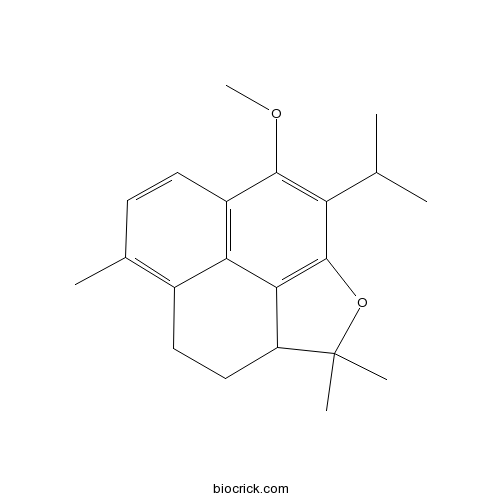PrionitinCAS# 117469-56-4 |

Quality Control & MSDS
Number of papers citing our products

Chemical structure

3D structure
| Cas No. | 117469-56-4 | SDF | Download SDF |
| PubChem ID | 9972696 | Appearance | Powder |
| Formula | C21H26O2 | M.Wt | 310.4 |
| Type of Compound | Diterpenoids | Storage | Desiccate at -20°C |
| Solubility | Soluble in Chloroform,Dichloromethane,Ethyl Acetate,DMSO,Acetone,etc. | ||
| Chemical Name | 9-methoxy-5,13,13-trimethyl-10-propan-2-yl-12-oxatetracyclo[6.5.2.04,15.011,14]pentadeca-4,6,8(15),9,11(14)-pentaene | ||
| SMILES | CC1=C2CCC3C4=C(C(=C(C(=C24)C=C1)OC)C(C)C)OC3(C)C | ||
| Standard InChIKey | CJIPRXHPKFHPKN-UHFFFAOYSA-N | ||
| Standard InChI | InChI=1S/C21H26O2/c1-11(2)16-19(22-6)14-8-7-12(3)13-9-10-15-18(17(13)14)20(16)23-21(15,4)5/h7-8,11,15H,9-10H2,1-6H3 | ||
| General tips | For obtaining a higher solubility , please warm the tube at 37 ℃ and shake it in the ultrasonic bath for a while.Stock solution can be stored below -20℃ for several months. We recommend that you prepare and use the solution on the same day. However, if the test schedule requires, the stock solutions can be prepared in advance, and the stock solution must be sealed and stored below -20℃. In general, the stock solution can be kept for several months. Before use, we recommend that you leave the vial at room temperature for at least an hour before opening it. |
||
| About Packaging | 1. The packaging of the product may be reversed during transportation, cause the high purity compounds to adhere to the neck or cap of the vial.Take the vail out of its packaging and shake gently until the compounds fall to the bottom of the vial. 2. For liquid products, please centrifuge at 500xg to gather the liquid to the bottom of the vial. 3. Try to avoid loss or contamination during the experiment. |
||
| Shipping Condition | Packaging according to customer requirements(5mg, 10mg, 20mg and more). Ship via FedEx, DHL, UPS, EMS or other couriers with RT, or blue ice upon request. | ||
| Description | Prionitin is a natural product from Salvia prionitis Hance. |
| Structure Identification | Journal of Organic Chemistry, 1992 , 57 (17).Cyclization reactions of the o-naphthoquinone diterpene aethiopinone. A revision of the structure of prionitin.[Reference: WebLink]
|

Prionitin Dilution Calculator

Prionitin Molarity Calculator
| 1 mg | 5 mg | 10 mg | 20 mg | 25 mg | |
| 1 mM | 3.2216 mL | 16.1082 mL | 32.2165 mL | 64.433 mL | 80.5412 mL |
| 5 mM | 0.6443 mL | 3.2216 mL | 6.4433 mL | 12.8866 mL | 16.1082 mL |
| 10 mM | 0.3222 mL | 1.6108 mL | 3.2216 mL | 6.4433 mL | 8.0541 mL |
| 50 mM | 0.0644 mL | 0.3222 mL | 0.6443 mL | 1.2887 mL | 1.6108 mL |
| 100 mM | 0.0322 mL | 0.1611 mL | 0.3222 mL | 0.6443 mL | 0.8054 mL |
| * Note: If you are in the process of experiment, it's necessary to make the dilution ratios of the samples. The dilution data above is only for reference. Normally, it's can get a better solubility within lower of Concentrations. | |||||

Calcutta University

University of Minnesota

University of Maryland School of Medicine

University of Illinois at Chicago

The Ohio State University

University of Zurich

Harvard University

Colorado State University

Auburn University

Yale University

Worcester Polytechnic Institute

Washington State University

Stanford University

University of Leipzig

Universidade da Beira Interior

The Institute of Cancer Research

Heidelberg University

University of Amsterdam

University of Auckland

TsingHua University

The University of Michigan

Miami University

DRURY University

Jilin University

Fudan University

Wuhan University

Sun Yat-sen University

Universite de Paris

Deemed University

Auckland University

The University of Tokyo

Korea University
- Cefditoren Pivoxil
Catalog No.:BCC4898
CAS No.:117467-28-4
- BCECF-AM
Catalog No.:BCC5969
CAS No.:117464-70-7
- Triptonodiol
Catalog No.:BCN6782
CAS No.:117456-87-8
- Wilforol E
Catalog No.:BCN8058
CAS No.:117456-86-7
- Xenin 8
Catalog No.:BCC5876
CAS No.:117442-28-1
- 2-Methyl-6-(p-tolyl)heptane-2,3-diol
Catalog No.:BCN7249
CAS No.:117421-22-4
- D-CPP-ene
Catalog No.:BCC6999
CAS No.:117414-74-1
- 4-O-beta-Glucopyranosyl-cis-coumaric acid
Catalog No.:BCN1608
CAS No.:117405-48-8
- AZD2461
Catalog No.:BCC2214
CAS No.:1174043-16-3
- Dimethylwulignan A1
Catalog No.:BCN3624
CAS No.:117404-43-0
- Artoheterophyllin B
Catalog No.:BCN6050
CAS No.:1174017-37-8
- Endothelin 3 (human, rat)
Catalog No.:BCC5713
CAS No.:117399-93-6
- Sesamoside
Catalog No.:BCN6051
CAS No.:117479-87-5
- ROX NHS ester, pure 6- isomer
Catalog No.:BCC3587
CAS No.:117491-83-5
- Neuromedin U (rat)
Catalog No.:BCC5847
CAS No.:117505-80-3
- Ustusol A
Catalog No.:BCN7719
CAS No.:1175543-02-8
- 2alpha,9alpha,11-Trihydroxy-6-oxodrim-7-ene
Catalog No.:BCN7741
CAS No.:1175543-03-9
- Ustusolate E
Catalog No.:BCN7789
CAS No.:1175543-06-2
- threo-6'-Hydroxyustusolate C
Catalog No.:BCN6930
CAS No.:1175543-07-3
- DMXAA (Vadimezan)
Catalog No.:BCC3644
CAS No.:117570-53-3
- Calpeptin
Catalog No.:BCC2351
CAS No.:117591-20-5
- Coronarin E
Catalog No.:BCN6052
CAS No.:117591-81-8
- 6-Hydroxymethylherniarin
Catalog No.:BCN3573
CAS No.:117597-79-2
- 1-Hydroxy-1-(4-hydroxy-2-methoxyphenyl)-3-(4-hydroxyphenyl)propan-2-one
Catalog No.:BCN1607
CAS No.:117614-84-3
Cyclization reactions of the o-naphthoquinone diterpene aethiopinone. A revision of the structure of prionitin.
Journal of Organic Chemistry, 1992 , 57 (17).
The 4,5-seco-20(10→5)-abeo-abietane derivative aethiopinone (1), a natural o-naphthoquinone isolated from some Salvia species, was subjected to a series of acid-catalyzed reactions which yielded phenalene derivatives (2, 6, 9, and 11) and other cyclization products (3 and 10). The 11-nor derivative 3 is formed by an intramolecular [4 + 2] cycloaddition reaction, and a mechanistic pathway for the formation of the phenalene derivatives 6 and 11 is also proposed. These transformations of aethiopinone (1) allowed the partial syntheses of the naturally occurring diterpenes salvipisone (8), salvilenone (9), and the racemic form of Prionitin (11), a rearranged abietane diterpenoid previously isolated from the root of Salvia prionitis, to which structure 12 had been attributed only on the basis of NMR spectroscopic studies. In the light of the results reported herein, including an X-ray analysis of compound 11, the structure 12 assigned to Prionitin must be changed to 11.


